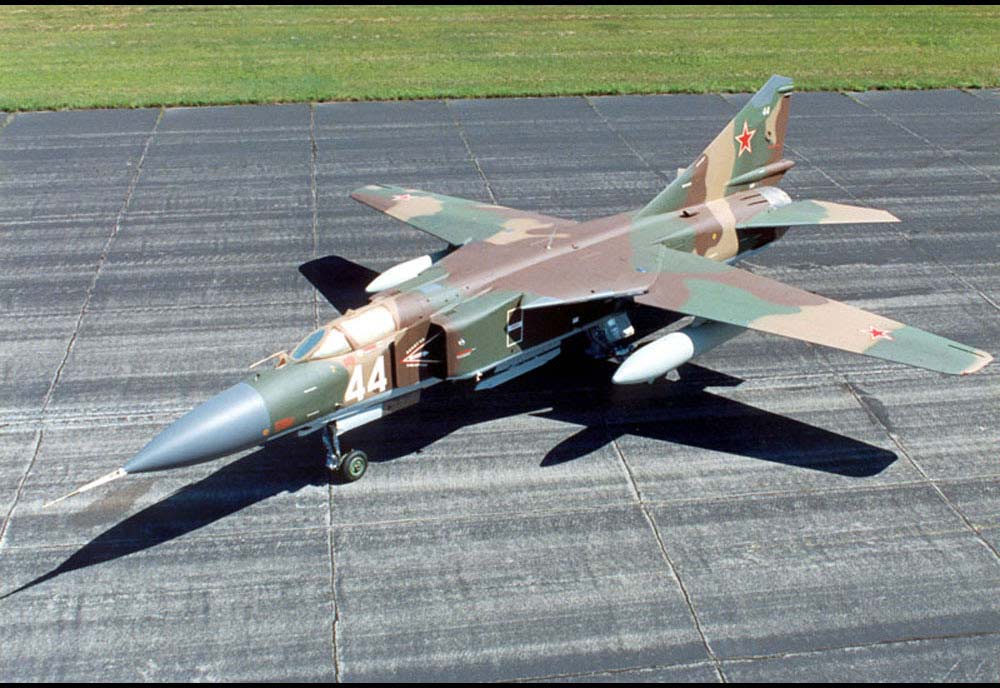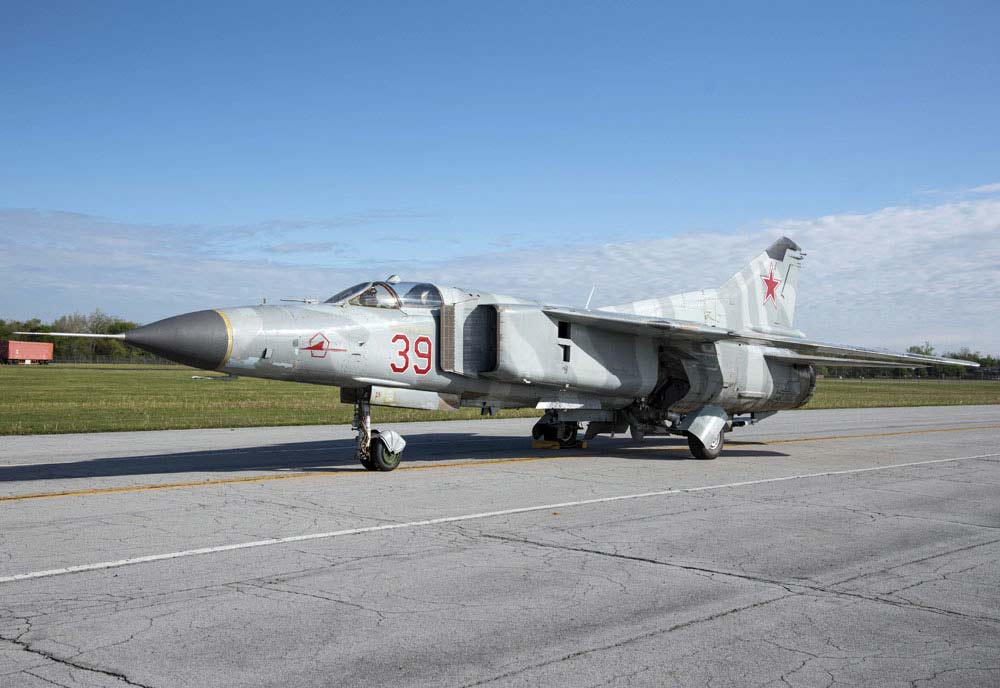The Mikoyan-Gurevich MiG-23 Flogger was a Soviet-era variable-geometry fighter aircraft, known for its speed and agility.
In brief
The Mikoyan-Gurevich MiG-23 Flogger is a third-generation, variable-geometry fighter aircraft developed in the Soviet Union. It was introduced into service in the early 1970s. The MiG-23’s design features a swing-wing that allows for improved performance across a wide range of speeds and altitudes. Powered by a single Khatchaturov R-35-300 jet engine, it can reach speeds up to Mach 2.35. Its armament includes a GSh-23L cannon, along with provisions for missiles and bombs on multiple hardpoints. The MiG-23 served as a versatile platform, with variants designed for air superiority, ground attack, and reconnaissance roles.

Development
During the height of the Cold War, the race for aerial supremacy between the NATO and Warsaw Pact countries necessitated rapid advancements in military aviation technology. The Soviet Union, seeking to match and surpass the capabilities of Western fighter aircraft, initiated the development of a new multi-role combat aircraft. This led to the creation of the Mikoyan-Gurevich MiG-23 Flogger, a project that began in the early 1960s under the direction of the Mikoyan design bureau.
The MiG-23 was developed to address the need for a versatile, high-performance fighter capable of operating in various combat scenarios. The primary objective was to create an aircraft that could effectively counter the latest NATO fighters, such as the F-4 Phantom II. The program was officially launched in the mid-1960s, with the first prototype taking to the skies on April 10, 1967.
The NATO reporting name “Flogger” was assigned to the MiG-23, following the tradition of assigning code names starting with ‘F’ for fighter aircraft. This name would become synonymous with Soviet aerial might throughout the Cold War era.
Design of the Mikoyan-Gurevich MiG-23 Flogger
The MiG-23’s most distinctive feature is its variable-geometry wings. These wings can be swept back for high-speed intercepts and forward for improved takeoff, landing, and low-speed maneuverability. The wing sweep can be adjusted from 16 degrees to 72 degrees, providing a significant tactical advantage in combat situations. The aircraft measures 56 feet 10 inches (17.32 meters) in length, with a wingspan varying from 45 feet 10.75 inches (13.98 meters) at its widest to 23 feet 5.5 inches (7.15 meters) when fully swept. It has a maximum takeoff weight of approximately 39,680 pounds (18,000 kilograms).
Powered by a Khatchaturov R-35-300 turbojet engine, the MiG-23 offers a thrust of up to 27,560 pounds-force (122.58 kN), enabling speeds of up to Mach 2.35. The aircraft’s design also incorporated advanced avionics for its time, including radar and missile guidance systems, improving its effectiveness as both an interceptor and a ground-attack platform.
However, the complexity of the swing-wing mechanism and the high maintenance requirements posed challenges. Additionally, the MiG-23’s performance at low speeds and during close combat maneuvers was considered inferior to some of its Western counterparts.
Performance of the Mikoyan-Gurevich MiG-23 Flogger
The MiG-23’s R-35-300 engine propels it to a top speed of Mach 2.35 (approximately 1,553 mph or 2,499 km/h) and allows operations at altitudes up to 60,700 feet (18,500 meters). Its range is about 1,150 miles (1,850 kilometers) without external fuel tanks, extending its operational flexibility.
When compared to contemporary Western aircraft like the F-4 Phantom II, the MiG-23 held its own in terms of speed and altitude capabilities. However, its maneuverability, especially at lower speeds, was often criticized. Despite this, the MiG-23’s versatility and adaptability across various versions ensured its widespread use.
Variants of the Mikoyan-Gurevich MiG-23 Flogger
The MiG-23 was produced in several variants, each tailored to specific roles. The MiG-23M and MiG-23MF were among the primary air superiority models, equipped with improved radar and weapons systems. The MiG-23BN and MiG-23B were dedicated ground-attack versions, featuring reinforced structures and different avionics suited for this role. The MiG-23MLD represented a significant upgrade over earlier models, with advanced aerodynamics, engine improvements, and enhanced electronic warfare capabilities. Each variant reflected the evolving needs of the Soviet Air Force and its allies.
Military Use and Combat of the Mikoyan-Gurevich MiG-23 Flogger
The MiG-23 saw extensive service across various theaters of conflict. Its armament typically included a GSh-23L twin-barrel cannon, air-to-air missiles (such as the R-23 and R-60), and provisions for bombs and rockets. This made the MiG-23 a formidable opponent in both air-to-air and air-to-ground engagements.
The aircraft participated in numerous conflicts, including the Middle East conflicts where it was operated by several Arab states against Israel. It saw action in the Soviet-Afghan War, providing air support and engaging in combat with mujahideen fighters. Despite its successes, the MiG-23 also faced losses, particularly in engagements where its maneuverability was challenged by more agile opponents.
The MiG-23 was exported widely, serving in the air forces of over 30 countries. Its combat history includes participation in the Iran-Iraq War, the Syrian Civil War, and other regional conflicts. Although many nations have phased out the MiG-23, some continue to operate it, albeit in limited numbers.

The Mikoyan-Gurevich MiG-23 Flogger represents a critical period in military aviation history, reflecting the technological ambitions and strategic necessities of the Cold War era. Despite its design challenges and operational limitations, the MiG-23 demonstrated the Soviet Union’s ability to produce a multi-role fighter that could adapt to the evolving demands of modern warfare. Its legacy is marked by its widespread use, diverse variants, and significant impact on numerous conflicts around the globe.
Back to the Fighter Jet section.